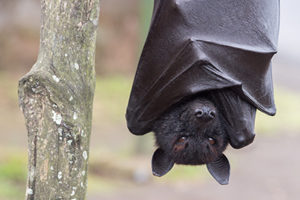
Flying Fox
Bats in the Pacific Northwest can generate a natural fear among many people. They are a widely misunderstood creatures that can bring lots of worry when they are in your home or structure. Bat colonies can cause a lot of structural and cosmetic damage to your property. Each day, a bat can expel an amount of waste equal to its own body weight. Over time, this waste, called guano, can build up and cause offensive odors and may spread a fungus called Histoplasma. Histoplasma is a fungus that commonly grows on bird and bat droppings and it can be a serious health threat to humans. Histoplasmosis is an infection caused by breathing in spores of a fungus found in bird and bat droppings. Histoplasmosis is most commonly transmitted when these spores become airborne; often during cleanup or demolition projects. This is the number one reason why you should address any bat problems immediately. Bat guano can spread this fungus and other bacteria as well, so it is incredibly important that you do not try to clean a contaminated area yourself.
During your initial free inspection, we will inspect the entire exterior of the structure to identify all potential entry points for bats. We will also inspect the attic and other enclosed interior areas for bat activity. This step involves identifying every point that the bats use or may eventually use to gain entry. Bats need less than 1/2 inch of space to gain access – so our inspection is quite thorough. After we have identified these access points we will work with you to develop a plan to rid your structure of the bats. This plan will always provide an unlimited treatment warranty.
As an experienced bat removal company, we can determine where bats are entering your structure and formulate a plan for their removal. Our goal is for complete bat removal from structure. We provide a humane exit strategy for the bats by fabricating gates that allow them to exit and not return. These exit gates for the bat eviction are vital to avoid trapping bats inside of a structure. Trapped bats become desperate and will seek alternative exit routes, possibly bringing them into your living spaces.
Removing bats requires the skills of properly trained professionals. Complete sealing of a home’s roofline, vents, and other areas is required to prevent entry. Most bat jobs are very detailed and complex, it is usually beyond the scope of what a homeowner can perform. A lot of our work may require working high above the ground on ladders, lifts, or working on steep pitched ridgelines, therefore safety is a prime reason to consider a professional.
When should bat guano be removed? Guano removal is always best done after the bats are gone. Guano should be removed from any place where a buildup of guano exists and is somewhere where it may be disturbed. Our technicians are trained to remove guano while minimizing the chances of spreading Histoplasmosis spores into the building. To protect our technicians, we require them to wear disposable clothing, eye protection and respirators. The guano is bagged and taken to a disposal facility. Once removed the area is then sanitized and deodorized to kill any lingering spores and contaminates.
Choosing the right company for your bat removal can be difficult. With All Natural Pest Elimination, you can rest easy that your structure will be bat-free because we have performed hundreds of bat jobs in the Northwest and we are one of the few local companies that specialize in bat removal. We are license by the Oregon Contractors Board (CCB #202246), the Oregon Department of Agriculture (CPO #1030110), and the Department of Fish and Wildlife (WCO #1010164).

